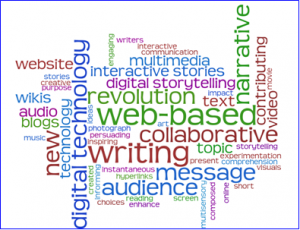In the last decade, technology has infiltrated society and become an integral component of everyday life. If you need convincing just visit the Eric Pickersgill‘s photo blog where he portrays the invasiveness of technology.

http://www.ericpickersgill.com/removed/
Social media connects us to our friends and family while news apps and blogs connect us to current events that are happening around the world. In this digital age many things are changing, including writing. The National Writing Project acknowledged the importance of the transition towards digital writing by releasing their new book, “Because Digital Writing Matters.” DeVoss, Eidman-Aadahl, and Hicks define digital writing as, “compositions created with, and often times for reading or viewing on, a computer or other device that is connected to the internet” (DeVoss, Eidman -Aadahl, and Hicks 2010). According to this definition digital writing encompasses a wide range of forms from blogging, to twitter, to texting. However, for the purpose of this essay I will mainly focus on blogging. In order to clearly represent the tenets of digital writing I will compare and contrast aspects of online writing to those of the traditional analogue and essay style of writing.
Digital Literacy
Before discussing the specific qualities of digital writing we should explore what it means to be digitally literate. In its most basic form literacy is very plainly the capacity to read and write. However, as we move towards digital writing we must add to that definition. As a multimodal platform, digital writing incorporates elements other than text. In my Writing in and for Digital Environments class the professor constantly pushes us to make our blogs multimodal. This can be rather difficult if you are new to technology or are just not very comfortable with it.
The purpose of making online writing multimodal is to engage all of the senses through the incorporation of videos, pictures, and links to relevant sources. In an article titled “Digital Literacy” Richard Lanham states that digital literacy, ” is the ability to understand information however it is presented (Lanham 1995). I would go one step further and say that digital literacy also requires one to have the ability to produce writing that can be understood through different mediums. A writer who can do this successfully, engages a broader audience which is critical to online writing and is something I will discuss in greater depth later in this piece.
IT’S ALIVE!
The most noticeable difference between digital and analogue writing is the organic versus inorganic nature of the piece. When writing an academic essay you follow a very formal and accepted path. Often you are handed a topic and then begin a literature search to find sources that will support a claim you have made based on class readings and discussions. In the next step you get together a rough draft that alternates between quotes and your own analysis. After receiving feedback from a professor or classmate you then revise the paper and turn it in. If what you just read sounded very formulaic and boring that’s because it is!
The organic nature of digital writing provides a stark contrast when compared to analog. In Cheryl Smith’s paper “Technologies for Transcending a Focus on Error: Blogs and Democratic Aspirations in First-Year Composition” she states that:
Digital writing resists a static notion of learning, in which the goal is a final paper that gets turned in for a grade, and instead prioritizes the development and circulation of ideas, which remain open to refinement and change. (Smith 2012).
Instead of your writing being personal, you are now publishing it for the entire internet community, where it will exist forever. This prospect can be both exciting and terrifying. Unlike a hardcopy of an essay, web writing platforms allow readers to comment on the work and share it with whomever they like. While this is stressful it can also add a sense of value to your writing. Instead of the audience being limited to two people, in the case of an academic paper, you are now able to reach an audience of millions.
As writing transitions from a personal practice to a communal practice the audience begins to play a much bigger role in both the development of the writing and the critique of the final product. In an articles titled “Digital Writing Uprising: Third Order Thinking in The Digital Humanities” Sean Michael Morris adds that when it comes to online writing, “There is no value to [it] except as it is made useful” (Morris 2012). This statement changes the criteria for what is considered valuable writing. The author is now supposed to write with the purpose of creating something useful to the online readers.

http://image.slidesharecdn.com/edulearn15lairecasteleynmottartdigitalmediawritingtoolsthetheoryofwritingcurriculatherealityofteachi-150703130637-lva1-app6892/95/edulearn-15-laire-casteleyn-mottart-digital-media-writing-tools-the-theory-of-writing-curricula-the-reality-of-teaching-practices-2-638.jpg?cb=1435928823
Knowing that you are writing for a global audience comes with the responsibility of appealing to many different personalities and points of view. As an author of an online work one also has to contend with how different members of the audience best absorb information. However, with multimodal resources at your disposal the challenge of appealing to a diverse group becomes a much more feasible task. Whether the audience could benefit from the use of pictures, videos, or links to background information on the topic, it is important that the author considers every possibility when designing a piece of web writing (Lanham 1995).
Why is it important?
In the digital age there is no slowing down. As millennials, we especially are expected to know how to use new technologies and keep on top of the new trends that exist in the digital world. This may seem like a burden, but becoming involved with digital writing has benefits as well.
Digital writing has proven itself useful as a way of learning and as a means of developing critical thinking skills. In traditional classes papers are typically assigned in which students in which they are expected to demonstrate a clear understanding of what has been taught in lecture and to potentially apply it to a new topic. Recently, professors at many universities have started using digital writing in the form of class blogs to challenge this model. In “Sister Classrooms: Blogging across disciplines and campuses” Hagood and Price declare that, “a course blog can create a uniquely powerful learning community that invites students to learn through writing, rather than use writing as a means to prove mastery” (Hagood and Price 2013). As students commented on each others blogs it prompted class discussions and led to students expanding on previous blog posts. As they constantly interacted with their own writing and the blogs of their classmates, students developed a better understanding of their strengths and weaknesses, and they began to develop into better writers (Hagood and Price 2013). In another article, titled “Writing as Curation,” Coco and Torres discuss how the method of “building” and “breaking” in blog writing fosters the development of critical thinking skills (Coco and Torres 2014). By nature, blog posts are relatively short pieces. This aspect forces the author to be concise and get directly to the point. This can be a challenge when trying to comb through various sources to to “build” a blog post. However, this challenge can greatly improve ones ability to think critically and make connections when practiced frequently, which the brevity of crafting posts allows.

http://digitalwritingresources.pbworks.com/f/1268088002/digital%20writing%20definition%20wordle.png
Digital writing is important because it ultimately pushes the author to create a better product. In “Consider the Audience” Jen Rajchel analyzed student surveys and found that, “When students feel an increased level of investment in their projects and a heightened sense of responsibility to an actual audience, the work becomes less about grades and more about shaping their scholarship” (Rajchel 2014). When you keep a blog, you commit to writing regularly and developing your writing skills while having the freedom to incorporate your own interests. To me it seems natural then that this method often produces better writing than traditional essay form. If being a good writer is a highly desirable trait in school and the professional world, writing digitally is of the utmost importance.
Personal Thoughts
From my own experience in a digital writing class I have found tremendous value in practicing digital writing. As a biology major I rarely write anything other than lab reports. However, I now blog almost every week and my writing has improved throughout the course of the semester. A few weeks ago the lacrosse team met with Phil Jones from the career center. He gave a presentation on how to secure internships and develop skills that companies repeatedly list as the most desirable qualities they look for in applications. Some skills varied across different industries but being a good writer remained constant. In my academic career at Dickinson I could have taken more writing courses and I regret not doing so. However, I now know that something as simple as blogging a couple days a week can act as a great tool to keep your writing skills.
When I sit down to write I almost feel as if I am using a different part of my brain or at least a different mode of thinking than when I’m doing math homework or studying for a test. While you think critically in both tasks, I feel as though I do it in a more deliberate fashion when I write. I think about each individual step I take and why it is related to the previous one instead of absentmindedly applying an equation. This deliberate way of thinking has made me more engaged in the subject material and caused me to take a step further than just gaining a general understanding of assigned readings.
After graduation I want to follow my dream of becoming a doctor and attend medical school. Much like the digital world, medical techniques and information is advancing and changing on a frequent basis. Publishing research is a requirement for physicians at most hospitals. Over the last few summers I have had the amazing opportunity to work alongside doctors and see what this process entails. When examining medical research and digital writing I can’t help but notice one glaring similarity, they are both communal practices. Every medical research article I have read lists the name of at least three authors on the top of the page. It is a collaborative process that involves critique and teamwork. The authors collaborate amongst themselves and reach out to other physicians across the country for feedback and direction. While the content is vastly different, the process is similar to that which exists in the blogosphere. If I can make a connection between blogging and conducting medical research I’m sure that this worthwhile practice can and should find a way into your regular habits.
Works Cited
Coco, Pete and Torres, Gabriela M. “Writing as Curation.” Web Writing: Why and How for Liberal Arts Teaching and Learning. (2014). Web. 25 Oct. 2016 http://epress.trincoll.edu/webwriting/chapter/coco-torres/
http://www.digitalpedagogylab.com/hybridped/digital-writing-uprising-third-order-thinking-in-the-digital-humanities/
